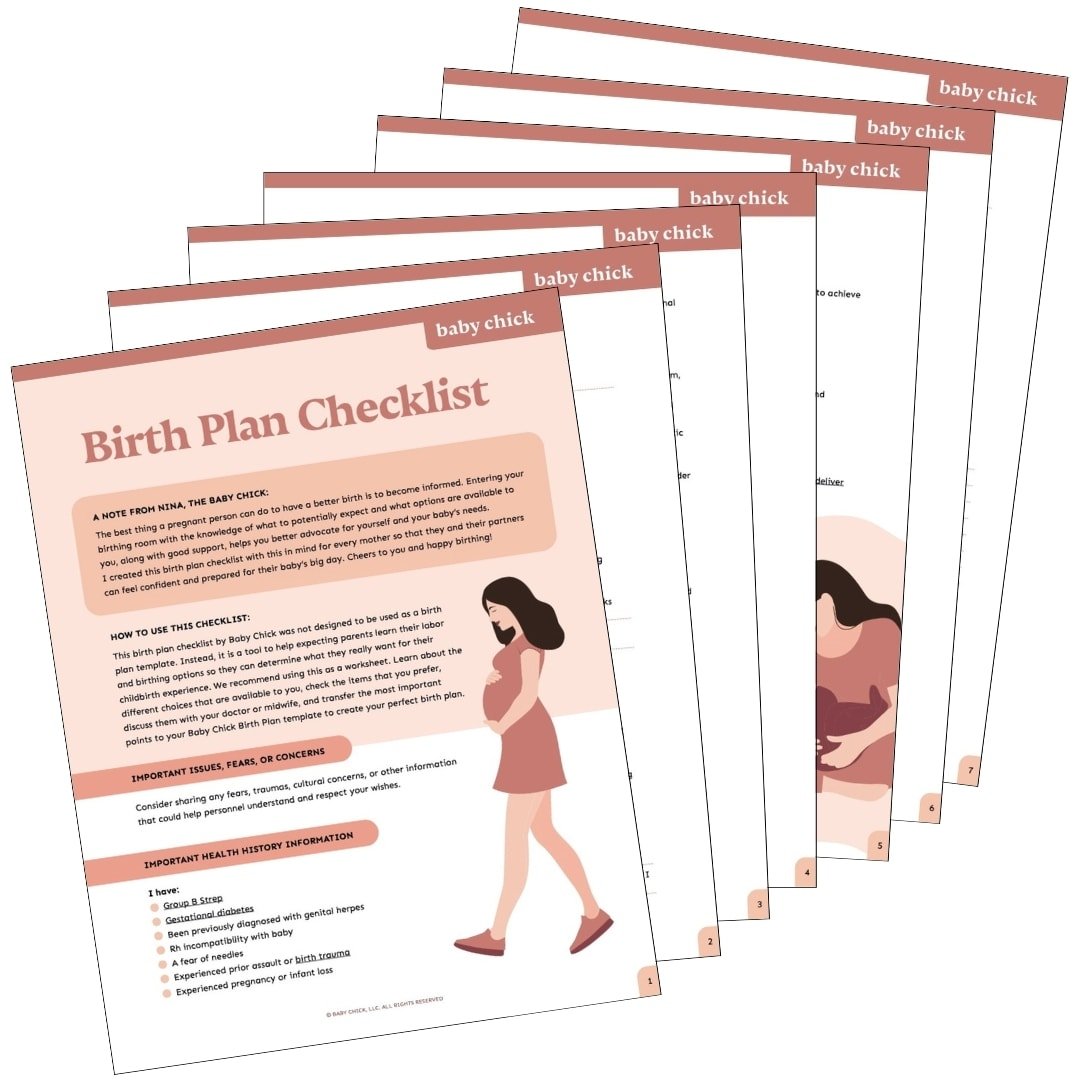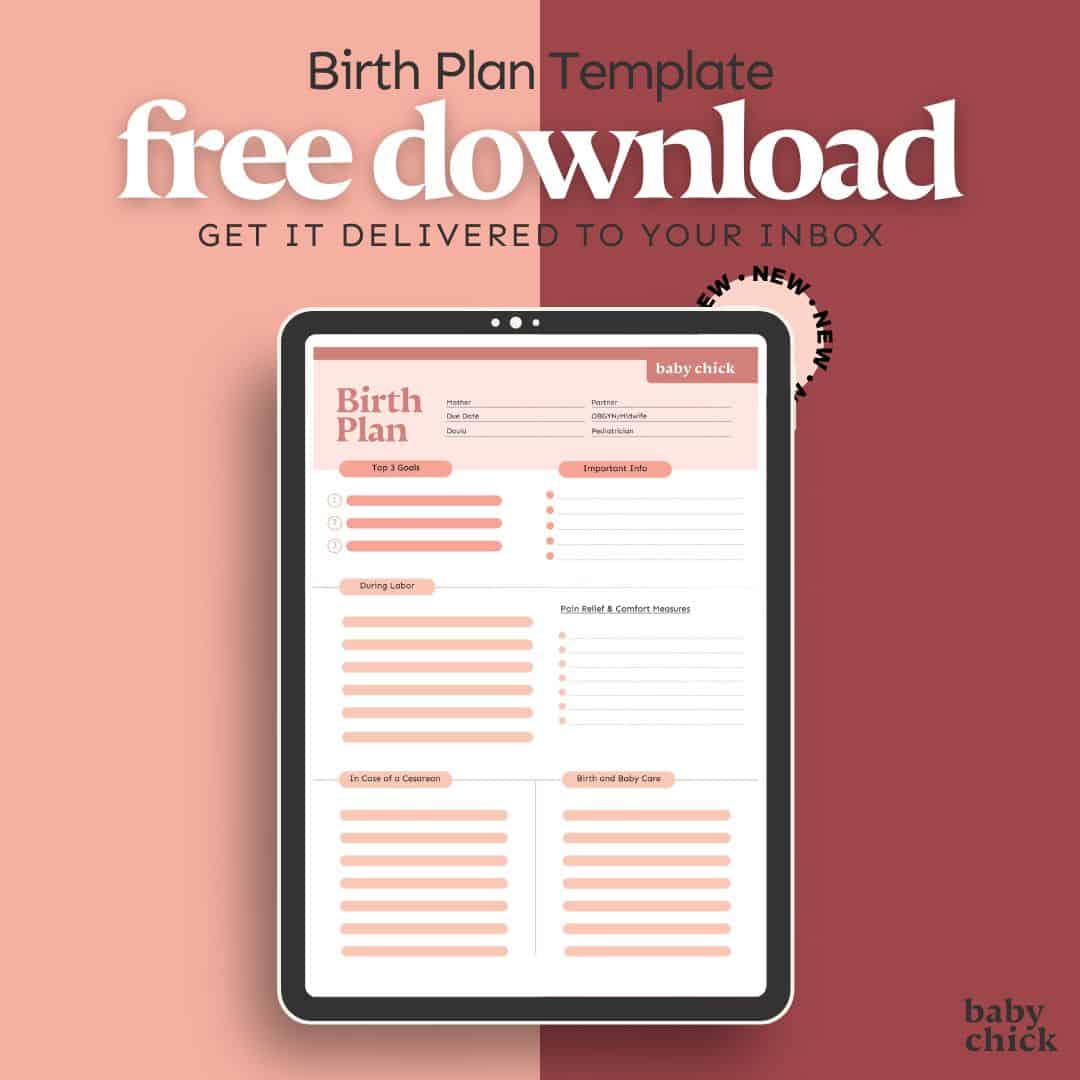With your due date quickly approaching, you probably have an idea of how you want your baby’s birth to go — whether that’s a natural (unmedicated) birth, an epidural, or a scheduled cesarean. There’s a lot to consider: your health, your baby’s needs, and what makes you feel safe and supported. Creating a birth plan can help clarify your preferences and guide your care team. In this article, I’ll explain what a birth plan is, why it’s helpful, how to write one, share birth plan examples, and provide a free birth plan template and checklist to help you create your own.
What Is a Birth Plan?
If you’re wondering, “What is a birth plan?”, it’s essentially a customizable guide that outlines your birth preferences and helps your care team support you better during labor and delivery. A birth plan is a written document prepared by the expecting mother/parents that lets their maternity healthcare team know their preferences during labor, during birth, immediately after birth, for baby care, and for recovery. In your birth plan, you can include things like:
- Managing labor pain
- Who will be allowed in the room during delivery
- How you would like to push
- If you want immediate skin-to-skin
- If you’d like to do delayed cord clamping or donate/bank your baby’s cord blood
The list goes on! Ultimately, your birth plan should be a one-page (front and back, at most) document listing the things that are most important for yourself and your baby during labor and birth.
Your Birth Plan = Birthing Intentions & Goals
You may hear some people say, “Creating a birth plan is a waste of time because nothing may go as planned.” But what I’d like to say to this remark is that the power of having a birth plan isn’t in having this documented “plan” to follow during labor. The value of creating a birth plan lies in the process of putting it together.
By researching and writing one, you learn about your options during labor, birth, and recovery. You’re understanding more and more of what to potentially expect and are discovering what you’d prefer in certain scenarios. By doing this exercise, you’re no longer walking into the labor and delivery room clueless and with tons of questions. With a prepared birth plan, you’re armed with the knowledge to better advocate for yourself and your baby during this life-changing time.
And that knowledge is powerful.
So, instead of thinking of this document as a “plan,” think of it as your birthing intentions or birth goals. It’s good to remain flexible and open to changes in your birth plan. But, again, the power of a birth plan is really about you learning the options available to you so you can improve your chances of having the positive birth experience you want.
Benefits of Having a Birth Plan
Here are the reasons why it can be helpful to create and have a birth plan:
1. Knowledge = Power and Confidence
As you approach your baby’s due date, you’re more than likely feeling anxious about it all. I want you to know that those feelings are normal. I’ve been to tons of births, and even I was a little scared about going into labor with my two kids. Birth is unpredictable, and the unknown can be scary. But, as I tell all my doula clients, the best way to combat those anxious and uneasy feelings is to educate yourself. The more you know, the better choices you can make for yourself and the more confident and prepared you’ll feel entering your labor and birth experience. With confidence, you improve your chances of having a more positive birth, and that’s powerful.1

2. You’re Better Able To Advocate for Yourself and Your Baby
Not only does knowledge about the labor and birth experience give you more confidence, but it also helps you speak up for the things that are important to you. You should be an active participant in your labor and your baby’s birth. This is your body and your baby. Your voice should be heard because you’re in charge, and you should be in the driver’s seat.
If you’re hoping to have an unmedicated birth, it can be a bit more challenging to speak up during labor. Labor takes all your energy to focus on getting through each contraction and helping move your baby down through your pelvis. A birth plan is helpful because you can remind people to review it and let it speak for you. It can remind your birth team about your preferences so they can honor them.
3. It’s a Helpful Guide for Your Partner
Maybe you’ve told your partner or support person helping you during labor and birth that they must remember all your desires. Of course, they’ll do their best to support you during the big day, but more than likely, because they’ve never supported someone through labor and delivery before, they won’t be precisely sure what’s happening every step of the way. They won’t know when or how to speak up and advocate for your preferences. This is why a birth plan can also be a helpful guide and reminder for your partner of what you both discussed.
Pro Tip: Fill out the birth plan checklist (see below) and birth plan template (see below) with your partner. The more involved they are in the prep work, the more helpful and involved they’ll be on the big day.
Also, having a professional in the room designated to remember all your choices, like a birth doula, is a great option. Even doulas like to have notes of what their clients’ preferences are. Some even require a birth plan from their clients so they can be the best advocate and support person during your baby’s birth. These are all great reasons to create the best birth plan for yourself.
4. Everyone Is on the Same Page, Literally
When you walk in with your birth plan, everyone is on the same page as you and understands your preferences. Remember, your doctor might not be on call when you go into labor. You could have multiple nurses caring for you throughout your experience. A birth plan will ensure that the doctor or midwife and nurses caring for you know your wants and desires. There are no questions about what’s important to you, and everyone is on the same page (literally).
How To Write a Birth Plan
Now that you know the benefits of creating a birth plan, it’s time to start putting yours together. Not sure how to write one or what to include? This is exactly why I created a birth plan checklist and downloadable template to make it easier for expecting parents! This document (which you can download below for free) allows you to look at all the different scenarios. By reading through the lists, you can ask yourself what you’d really prefer. I include unmedicated options to elective cesarean options, and everything in between. This way, you can truly choose what feels best for you.
Birth Plan Checklist

You can also download our free birth plan template (PDF) at the bottom of this article to help finalize your top priorities.
I want to mention that not all the options on my birth plan template above will be available to everyone. It depends on where you choose to give birth and the options available to your care provider. Also, some of these options might not be available if you have complications during your pregnancy or have a high-risk pregnancy. Talk about it with your care provider.
Note: Do NOT use the above checklist as your birth plan. Instead, use it as a tool to become informed and help you decide what should go on your birth plan. Print it out and check off the things you prefer, then transfer the most important ones to your birth plan (template available below). If you have questions about some points, bring this checklist to your prenatal visits and review it with your doctor or midwife. Then, you’ll feel informed and can determine which items you checked off should be transferred to your birth plan. Now, let’s begin! (Also, watch this YouTube video on writing a birth plan!)
What Should Go on Your Birth Plan?
Follow these steps to write out your birth plan:
1. Your General and Important Information
At the top of your birth plan, list your general information and the most important information your healthcare team needs to know about you. This is where you include details like:
- Your name
- Your partner’s name
- Your due date / how many weeks and days you’re pregnant
- Your doula’s name (if you have one)
- Your baby’s pediatrician
Regarding important information, write down any medical history they need to know. Some examples include:
- If you’re GBS positive
- Have gestational diabetes
- Have preeclampsia
- High blood pressure
- Have an STI
- Placenta previa
- Experienced trauma in the past
- If this is your first, second, third, etc., child
2. What You Prefer During Labor
A main point your labor and delivery team wants to know is what you prefer for pain relief. If you’re hoping for a vaginal birth, do you want to go natural/unmedicated, or do you want medication for pain relief? If you’re unsure what you want, I recommend looking at this Pain Management Preference Scale written by Penny Simkin, a physical therapist. It can help you better understand where you stand if you’re on the fence about this decision.
Some things to consider when writing your birth plan:
- Who do you want in your labor and delivery (L&D) room with you? (Are residents allowed?)
- How much movement do you want to have? (Pain medication does limit you.2)
- Do you want an IV or hep-lock?
- Would you like to use a birthing ball and/or peanut ball?
- Would you like to labor in a tub or shower?
- Do you want to play a birth playlist?
- Do you want to wear your own clothing?
- Would you like to eat and drink freely during labor?
- What type of pain medication do you want/are you open to?
- Epidural or spinal
- Nitrous oxide
- IV pain medication
- General anesthesia
- Or would you prefer natural pain relief methods?
- Hot and cold compresses
- Counterpressure and massage
- Acupressure
- Hydrotherapy
- Aromatherapy
- Etc.
There are a lot of options, and you should consider what you’d like for your labor experience. Even consider “plan B” scenarios. What if your labor stalls out? Are you open to Pitocin, or would you rather have the option to walk the halls and do nipple stimulation first? Or perhaps you’re okay with them breaking your water, or maybe you’re totally against it. By creating a birth plan, you learn all your options. This helps you determine your top preferences and what you’d like to happen next if things don’t “follow your birth plan.”
3. Pushing Preferences
Once your cervix has fully effaced, is 10 centimeters dilated, and your baby is engaged in your pelvis, it’s time to start pushing!3,4 But how do you prefer to push? Do you want to:
- Push upright
- Squat (use a squat bar?)
- Push on your side
- Spontaneously push
- Be coached while pushing
- Push while kneeling
- Push on all fours
- Use stirrups
- Have a water birth
- Have a mirror to help you see when you’re pushing effectively
Not all of these options may be available to you, depending on where you’re choosing to give birth and if you choose certain pain medications. Go over them with your doctor or midwife, and see which ones you’re interested in.
4. In Case of Emergency
As I mentioned before, birth is an unpredictable event. Sometimes, things come up, and we have to change the plan to have a healthy mom and baby. If you or your baby experiences an emergency scenario, it’s good to have an understanding of what could happen. If you’re pushing and your baby needs to be quickly delivered, are you familiar and comfortable with second-stage interventions like a vacuum birth, forceps, or getting an episiotomy? Do you know how these are performed and the benefits and risks of each?
Maybe your baby needs to be born even sooner, and an emergency C-section is necessary. There are still things to ask and consider:
- Are you okay with both arms being restrained or having one arm free to hold your baby?
- Do you want a gentle cesarean?
- Would you like your doctor to talk you through the surgery so you know how things are going?
- Would you like a clear drape?
- Do you want music so your baby is born with a particular song playing? (Your partner can play it on their phone.)
- Do you want your partner to announce the gender? (If you were keeping it a surprise!)
If you know in advance that you need or want a C-section, it’s still a good idea to have a birth plan with a C-section. We want you to be informed and have the best experience possible.
5. Immediate Postpartum and Newborn Procedures
Once your baby is born (congratulations!), there are still some options you should think about and know. For example:
- Do you want to do delayed cord clamping?
- Are you going to save your placenta? (Maybe you’ll encapsulate it or do placenta banking.)
- Do you want immediate skin-to-skin and have the golden hour?
- Are you okay with baby receiving their vitamin K shot, hepatitis B vaccine, erythromycin eye ointment, and PKU (phenylketonuria) testing?
- Do you plan to breastfeed or formula feed?
- Are you okay with baby being given formula or sugar water at the hospital?
- Do you want baby to stay with you, or do you prefer they go to the nursery to get some sleep? (If you plan to breastfeed, you can ask the nurses to bring your baby to you when they’re hungry.)
- Would you like to see a lactation consultant?
- Are you going to delay baby’s first bath?
- Would you like your postpartum nurses to couple your night care? (This way, you won’t be woken up every 30 minutes to an hour for them to check your vitals.)
There’s all of this and more to think about! Writing this in your birth plan helps them know your wishes, not only for labor but even after your baby is born.
6. Your Top Three
I like to ask my clients, “What are the top three things that are most important to you during your labor and birth?” It’s nice to be able to see your biggest priorities at the top of your birth plan. Our birth plan template (which you can download for free below) has a highlighted “Top Three” section. This ensures your team quickly understands what’s most important to you if other things don’t work out. Some ideas here could be:
- A vaginal birth
- A VBAC
- Not getting an episiotomy
- To labor freely
- To get an epidural as soon as possible
- To have your partner announce the baby’s gender
Birth Plan Examples & Sample Templates
These sample birth plans show a variety of approaches, from unmedicated births to planned cesareans.
Example 1: Unmedicated Birth #1

Example 2: Unmedicated Birth #2

Example 3: VBAC With Epidural

Example 4: Unmedicated Birth #3

Example 5: Cesarean Birth

Tips for Writing Your Birth Plan

Here are some tips for when you’re creating your birth plan:
1. Keep It Simple
Your care providers don’t have time to review a six-page birth plan. They also won’t remember everything because they’re (most likely) caring for multiple laboring women at the same time. I suggest keeping your document to one page — front and back, at most. They will thank you for this and will be better at following your wishes.
2. Be Flexible
In my doula career, I’ve seen some expecting women be a bit too adamant about their birth plans. While I want every woman to have the labor and birth they want, I also think it’s important to remain flexible. Women must understand that controlling every aspect and outcome of their labor and birth isn’t always possible. Yes, you absolutely should have a say on how you want to labor and give birth, but because birth is unpredictable, being flexible and open-minded when thinking about your birth experience and writing out your birth plan is helpful. Of course, we hope that everything goes well and you get the birth experience you want. Just remember that things can happen and that flexibility with your “plan” is key.
3. Go Over It With Your Medical Provider Before Labor
When working on your birth plan, I recommend talking about your choices with your care provider during your prenatal visits. This will ensure your doctor or midwife is on the same page as you and supports you with all your wishes. Bring a final copy with you at the end of your pregnancy to review and go over with them once more.
Because doctors and midwives care for many patients, bringing your birth plan to the birth as a reminder about these details will help remind them of your discussions and what’s most important to you. I don’t recommend relying on them to remember your conversations.
4. Bring Multiple Copies With You
Because every person’s birth preferences are different, be sure to bring multiple copies of your birth plan with you. This way, you can give a copy to your doula, your doctor or midwife, and each nurse who walks into your room.
Note: Nurses usually work in 12-hour shifts and typically change at 7 a.m. and 7 p.m. You may have more than one nurse supporting you during labor, so have a few copies just in case. (Yes, for some mothers, labor can last longer than 12 hours!)
What To Do With Your Birth Plan?
Now that you’ve gone through our Birth Plan Checklist and decided on your labor, birth, and recovery preferences, you’re ready to put them into your birth plan! By transferring the things that are most important to you onto a one-page document, you’ll identify your top priorities. And your birth plan will help you remember these details on the big day.
Below, I’m sharing our birth plan template that I’ve used with all my doula clients. It’s printable and customizable, and has been used by hundreds of families preparing for childbirth.
Feel free to print it out or download it and use it as a guide:

Ultimately, I don’t want you to be a bystander and let “childbirth” happen to you. Advocate for yourself and be an active participant. By educating yourself and creating a birth plan, you’ll feel more prepared and confident for your baby’s birth day. There are so many ways to have a baby, and it should be the experience you want it to be. You only get to birth this baby once, and that experience will stay with you forever, so let’s make it a positive one.
With these birth plan tips, checklist, examples, and our free template, I hope you feel more ready than ever to welcome your baby. Happy birthing!
🤰 Feeling overwhelmed by pregnancy or unsure how to prepare for birth? Our NEW Pregnancy & Birth Prep App walks you through an 8-week challenge with daily bite-sized expert-backed tips, checklists, and real support. Everything you need for a more confident and positive experience! 🙌












